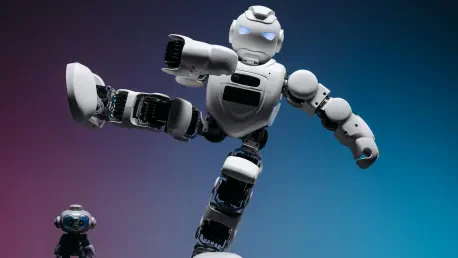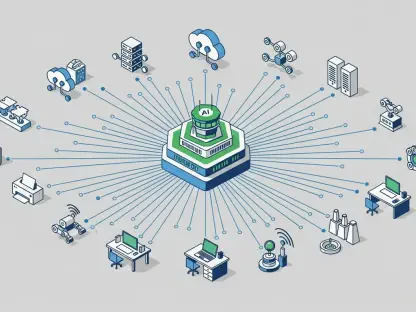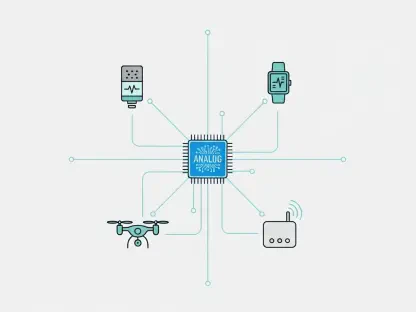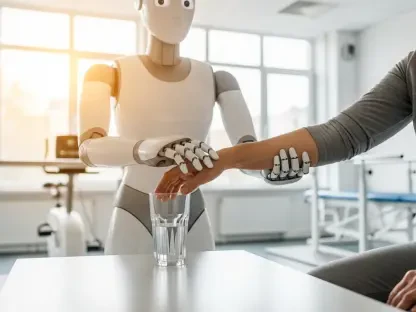In the rapidly evolving landscape of robotics, humanoid robots such as Tesla’s Optimus and Boston Dynamics’ Atlas have captured the imagination with feats that mirror human capabilities, from folding laundry to executing complex maneuvers. Yet, beneath this veneer of sophistication lies a persistent challenge that threatens to stall their progress. Despite remarkable strides in artificial intelligence (AI), a critical shortcoming in their physical design prevents these machines from achieving true versatility in unpredictable, real-world environments. This issue, rooted in rigid structures and an over-reliance on software, raises questions about whether current approaches are sufficient to bridge the gap between controlled demonstrations and practical applications. As the demand for robots to assist in everyday tasks grows, addressing these fundamental flaws becomes not just a technical necessity but a defining factor in shaping the future of this technology.
Current Challenges in Humanoid Robot Design
Rigid Structures and Limited Adaptability
Humanoid robots, while visually striking with their human-like forms, often falter when faced with the unpredictability of real-world settings due to their inherently rigid physical structures. Unlike humans, who adapt seamlessly to uneven surfaces or sudden obstacles through flexible joints and sensory feedback, robots like Atlas struggle to navigate terrains as simple as mossy rocks or crowded spaces. This limitation stems from a design philosophy that prioritizes mechanical precision over adaptability, resulting in bodies that cannot passively conform to external conditions. The consequence is a reliance on complex algorithms to compensate for physical shortcomings, which often leads to delayed responses and inefficient movements. This gap between controlled lab environments and dynamic real-world scenarios highlights a critical barrier to the widespread deployment of these machines in roles requiring fluid interaction with varied surroundings.
Another dimension of this challenge lies in the stark contrast between human and robotic movement efficiencies. Human bodies leverage a combination of muscle memory, tactile feedback, and joint flexibility to perform tasks with minimal conscious effort, whereas humanoid robots depend heavily on vision-based systems and pre-programmed responses. For instance, when Tesla’s Optimus folds a t-shirt, it relies almost entirely on computational power rather than tactile adaptability, making the process slower and less intuitive than a human’s approach. This over-dependence on active control systems not only hampers real-time responsiveness but also underscores the absence of inherent physical intelligence in current designs. Until robot bodies can mimic the passive adaptability seen in nature, their ability to handle unforeseen challenges will remain limited, confining many to experimental rather than practical use.
Energy Inefficiency
The energy demands of humanoid robots reveal another significant hurdle in their design, as their power consumption far exceeds that of humans performing similar tasks. Tesla’s Optimus, for example, requires approximately 500 watts per second to execute a basic walking motion, a stark contrast to the 310 watts per second a human expends during a brisk walk. This nearly 45 percent higher energy requirement is exacerbated by the constant micro-adjustments needed to maintain balance, which rapidly deplete battery reserves. As a result, operational times are often restricted to just a few hours, severely limiting the practicality of these robots for sustained tasks in industrial or domestic settings. Such inefficiencies pose a substantial obstacle to their integration into environments where long-term functionality is essential.
Beyond the raw numbers, the implications of this energy inefficiency extend to the broader feasibility of humanoid robots in everyday applications. The need for frequent recharging or battery swaps not only disrupts workflow but also increases operational costs, making these machines less viable for widespread adoption. Moreover, the weight of the power systems required to support such high consumption adds to the bulk of the robot, further reducing agility and maneuverability. This creates a vicious cycle where the physical design constraints amplify energy demands, and vice versa, stalling progress toward creating robots that can operate autonomously for extended periods. Addressing this issue demands a reevaluation of how energy is utilized and stored within the robot’s framework, pushing for innovations that prioritize efficiency over brute computational force.
Industry Practices and Barriers
Software-Centric Focus
At the heart of many design challenges in humanoid robotics lies an industry-wide emphasis on software solutions over hardware innovation, a trend that often overlooks the importance of a physically capable body. The predominant “brain-first” approach focuses on developing sophisticated AI and high-precision actuators to control every movement, resulting in robots that are computationally advanced but physically constrained. This imbalance means that even cutting-edge algorithms cannot fully mitigate the limitations of rigid structures, leading to heavier machines that require more power to function. The consequence is a persistent inefficiency where advancements in software hit a wall due to the lack of complementary progress in creating lightweight, adaptable bodies, ultimately hindering overall performance.
This software-centric mindset also manifests in the type of expertise and resources allocated within the robotics sector, often sidelining mechanical innovation. Many leading companies prioritize computational problem-solving, investing heavily in vision systems and machine learning models while treating the robot’s body as a secondary concern. Such an approach results in designs that depend excessively on active sensors and processors to navigate even simple tasks, rather than embedding passive adaptability into the hardware itself. This not only drives up energy consumption but also limits the robot’s ability to respond instinctively to environmental changes. A shift in focus toward integrating physical intelligence could alleviate these burdens, allowing AI to handle higher-level decision-making rather than micromanaging every motion.
Resistance to Change
The robotics industry’s reluctance to pivot from established practices presents a formidable barrier to addressing design flaws in humanoid robots. Major companies operate within ecosystems optimized for high-precision motors, sensors, and software development, creating a supply chain that is ill-suited for the advanced materials and biomechanics needed for more adaptive designs. Overhauling these systems to accommodate new philosophies, such as integrating flexible structures, involves significant financial investment and a complete rethinking of manufacturing processes. This inertia is compounded by the risk-averse nature of large-scale tech enterprises, which often prefer incremental improvements over disruptive changes, even when current hardware proves insufficient for real-world demands.
Additionally, the complexity of redesigning robot bodies extends beyond mere cost to the challenge of aligning diverse stakeholders around a new vision. Research into novel materials or compliant mechanisms often requires interdisciplinary collaboration, bridging gaps between software engineers, material scientists, and biomechanical experts—a process that can be slow and fraught with logistical hurdles. Meanwhile, the market pressure to showcase immediate results with existing technology further discourages long-term investment in unproven approaches. Despite these obstacles, the growing acknowledgment of physical design limitations suggests that change, though gradual, is inevitable. Overcoming this resistance will require bold leadership and a willingness to prioritize long-term innovation over short-term gains.
A Path Forward with Mechanical Intelligence
Nature-Inspired Solutions
A transformative approach to overcoming the design flaws of humanoid robots emerges through the concept of mechanical intelligence (MI), which seeks to embed adaptability directly into a robot’s physical structure. Drawing inspiration from natural systems—such as pine cones that adjust to humidity or the energy-storing tendons in a hare’s legs—MI focuses on creating bodies that can passively respond to environmental stimuli without relying on power-intensive processors. By incorporating compliant joints and adaptive materials, this method reduces the computational load on AI systems, enabling robots to interact with their surroundings more naturally. Such a shift could significantly enhance efficiency, allowing machines to conserve energy while navigating complex, unpredictable settings with greater ease.
The potential of MI lies in its ability to fundamentally redefine how robots are built, moving away from rigid frameworks toward designs that mimic the resilience and flexibility of living organisms. Imagine a robot with joints that automatically adjust to uneven terrain, or limbs that store and release energy like animal muscles, minimizing the need for constant software intervention. This passive intelligence not only cuts down on energy consumption but also improves durability, as the robot’s body can absorb shocks and stresses more effectively. Implementing these nature-inspired solutions requires a departure from conventional engineering norms, but the payoff could be robots that operate with a level of autonomy and grace currently unattainable, bridging the gap between mechanical marvels and practical tools.
Emerging Trends and Research
Encouraging signs of change are evident within the robotics field, as growing recognition of physical design limitations prompts calls for innovative approaches like MI. Notable initiatives, such as Sony’s push for research into flexible structural mechanisms, reflect an industry awakening to the need for robots that balance computational prowess with physical adeptness. This trend underscores a broader consensus among experts that future advancements must integrate hardware and software harmoniously, rather than treating them as separate domains. By prioritizing adaptable bodies alongside intelligent algorithms, the sector could unlock the potential for robots to thrive in real-world applications, from disaster response to household assistance, where versatility is paramount.
Concrete examples of progress further illuminate the path ahead, with research into hybrid hinges that combine rigidity with compliance offering a glimpse of MI’s practical impact. These innovations aim to address core issues like energy inefficiency and limited adaptability by enabling robots to perform tasks with less active control, conserving power while enhancing responsiveness. Such developments suggest a future where humanoid robots are no longer confined to research labs but are seamlessly integrated into daily life, capable of handling diverse challenges with minimal oversight. As these efforts gain traction, they pave the way for a new era of robotics, one defined by machines that mirror the efficiency and elegance of nature itself, setting a foundation for transformative applications across industries.









